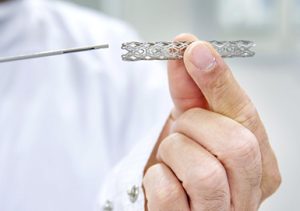A coronary stent is a tiny, expandable mesh tube used to treat blockages in the coronary arteries, which supply blood to the heart muscle. It is inserted during a procedure called coronary angioplasty or percutaneous coronary intervention (PCI). The stent is placed in the narrowed or blocked artery to open it up and restore blood flow to the heart. The stent acts as a scaffold, keeping the artery open and preventing it from re-narrowing. Coronary stents have greatly improved the treatment of coronary artery disease, relieving symptoms and reducing the risk of a heart attack.
Who would need a coronary stent?
This minimally invasive approach is often recommended for patients experiencing symptoms of reduced blood flow or those at high risk of a heart attack. However, a cardiologist may also suggest a stent after proper investigation if you have any of the below symptoms.

- Individuals with coronary artery disease (CAD) or blocked/narrowed coronary arteries.
- Patients experiencing symptoms of angina (chest pain) or other signs of reduced blood flow to the heart.
- Those who have had a heart attack or are at high risk of having one.
- People who have undergone coronary angiography and have identified significant blockages in their coronary arteries.
- Candidates who may not be suitable for bypass surgery or prefer a less invasive treatment option.
How the need for inserting a stent diagnosed?
The need for a coronary stent is typically diagnosed through a combination of medical evaluation and diagnostic tests. The process involves the following steps:

- Medical Evaluation: A healthcare provider will assess the patient’s medical history, symptoms, and risk factors for coronary artery disease (CAD) or blockages in the coronary arteries.
- Physical Examination: The healthcare provider will perform a physical examination, including listening to the patient’s heart and checking for any signs of reduced blood flow or cardiac abnormalities.
- Diagnostic Tests: Various tests may be conducted to evaluate the condition of the coronary arteries and determine the need for a stent. These tests may include:
- Electrocardiogram (ECG)
- Stress Test
- Coronary Angiography
- Cardiac CT Scan
- Echocardiogram
What ate the risks of a stent?
While complications related to the procedure are generally uncommon and not severe, patients should be aware of potential risks.
- Bleeding
- Swelling
- Infection
- Blood clots
- Stroke
- Heart attack
- Kidney problems
- Abnormal heart rhythms